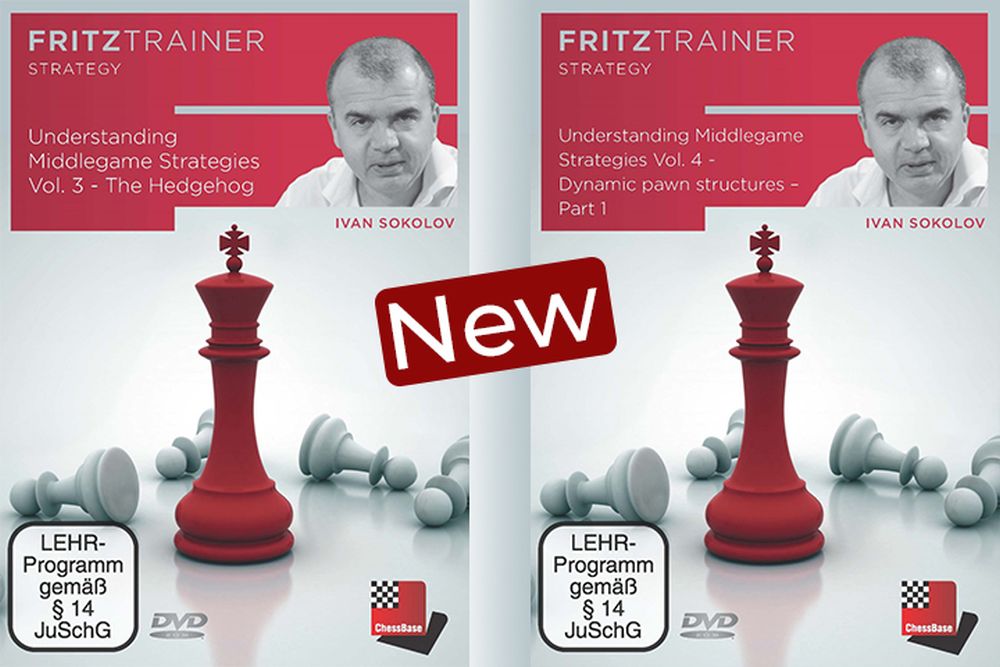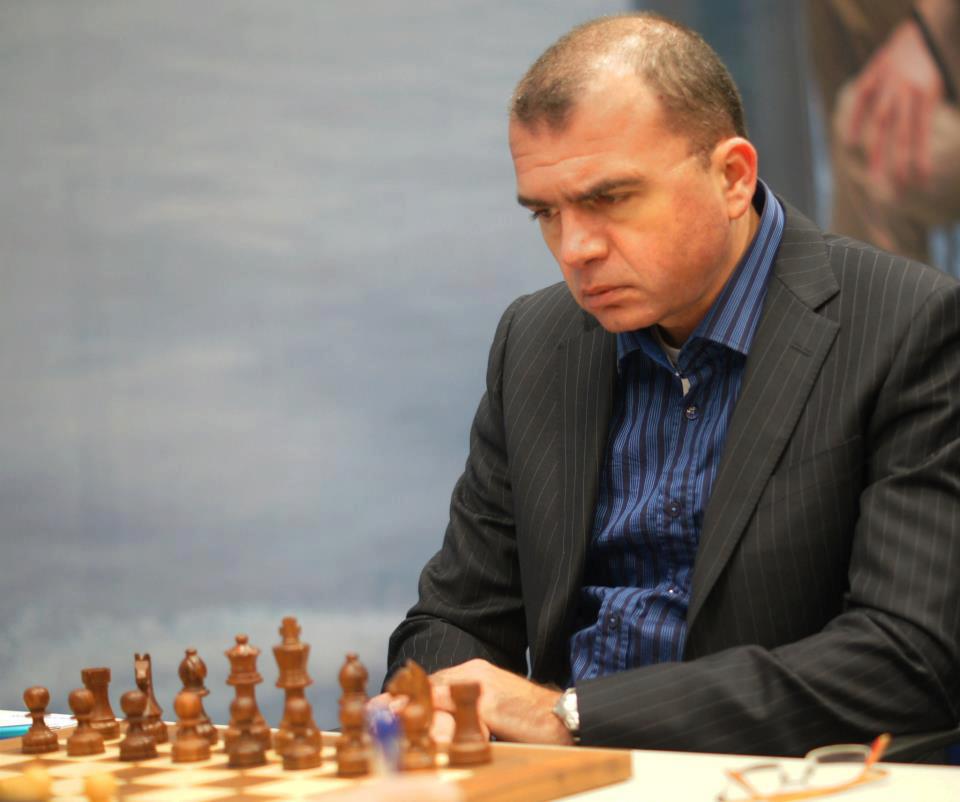New: Understanding Middlegame Strategies Vol. 3 + Vol. 4 by Ivan Sokolov
Ivan Sokolov is well-known for his stunning attacking games. Most of them originate from middlegames, so no wonder he wrote various books about this topic. Now he continues his video series at ChessBase and presents further tools for a better chess understanding with the hedgehog and dynamic pawn structures. Not only as a player, but also through his work as a trainer of various top players, Sokolov knows how to make complex topics understandable through instructive examples. Start improving your understanding of the middlegames now! Vol. 1 Dynamic Pawns and Vol.2 Practical Play released last year, now you can get Vol. 3 The Hedgehog and Vol.4 Dynamic Pawn Structures - Part 1. Photo: ChessBase
Understanding Middlegame Strategies: Vol. 3 - The Hedgehog by Ivan Sokolov

Throughout my playing career I have found the Hedgehog (with both colours) one of the most difficult type of positions to master. With White (the side with more space) there is always a danger to overextend oneself (or miss your opponent’s pawn break). While playing Black (the side with less space) there is always a danger to mistime your pawn break, or simply to not get counterplay and be overrun.
The complexity of those positions is best illustrated in a Kasparov-Kramnik game – with both players allowing seemingly “obvious” mistakes. Charbonneau-Anand is another good example – a player of Anand’s stature landing in a terrible position, then missing his good attacking prospects. The game result was one of the biggest upsets of 2006 Chess Olympiad. There are different types of Hedgehog positions - many of them coming from the English opening where the White bishop is fianchettoed. In this video course I consider the “basic Hedgehog” pawn structure; like the one coming from the Kan Sicilian for example.
Choosing the right plan at the right time is the key here - the ensuing positions are full of dynamic possibilities. I endeavour to show the most common (and a few less common!) plans for both sides and try to pinpoint typical mistakes and motifs. The basic aim of this video is to improve understanding of these complex positions and to help tournament players score better! For those who haven’t recently done any calculation training, there is the Calculation Training Booster. After all, every chess brain needs regular stimulation, as you don’t want to become a lazy player - avoiding calculating critical variations or simply failing to calculate properly.
In this video course, twenty-nine examples with multiple questions are presented in the interactive format, which is ideal for a range of playing strengths. Step by step you will be taken through the complex positions, in which you will have to get the most out of it for both sides. Calculation is not only about finding the right move, but also anticipating your opponent’s ideas. Therefore, several times you will be challenged to find the best defensive resource, and also to refute your own wrong answers.
The type of exercises are comparative to earlier video courses in the Calculation Training series, just with all the examples taken from more recent games. So, there’s plenty of new training material to challenge yourself with!
• Video running time: more than 5 hours (English)
• With interactive training including video feedback
Understanding Middlegame Strategies: Vol. 4 - Dynamic pawn structures – Part 1 by Ivan Sokolov
Isolated pawn structures can obviously come from many different openings. In this video course I have picked up isolated pawn structures coming from the classical Tarrasch defence D34; for which a considerable part was inspired by the games of Garry Kasparov.
I believe studying the classical Tarrasch isolated pawn structures (and related pawn structures) to be an excellent way to improve understanding of those types of positions. Choosing my games selection, I wanted to show typical plans for both sides based on high level instructive games.
Hanging pawns in the centre can come from different (though usually 1.d4 systems) openings. “Hanging pawns in the centre” structures are difficult to master because a good feeling for the “transformation timing” is needed! Sometimes those “transformations” are pawn-break related, unleashing dynamic power; while sometimes they are related to taking space and not being bothered about surrendering central squares. I have tried to show typical plans aiming to improve the viewer’s knowledge, and also practical play level.
Sicilian Rauzer double f-pawn structures are fashionable nowadays and are seen at all levels. Dynamic timing is everything! Most of the time, temporary pawn sacrifices are an essential part of this “dynamic timing”.
While it is difficult to give exact set of rules here, typical ideas do repeat themselves and I have tried to show these in this video course. Studying this video course should greatly improve the viewer’s handling of these dynamic positions! As with all my other video courses material here is predominantly aimed at improving players and tournament players.
• Video running time: 5 hours 30 minutes (English)
• Extra: Training with ChessBase apps - Play key pawn structures against Fritz on various levels
System Requirements
Minimum: Dual Core, 2 GB RAM, Windows 7, DirectX 11 graphic card with 256 MB RAM, Windows Media Player 9, ChessBase 14/Fritz 16 or included Reader and internet access for program activation.
Recommended: PC Intel i5 (Quadcore), 4 GB RAM, Windows 10, DirectX11, graphics card with 512 MB RAM or more, 100% DirectX10-compatible sound card, Windows Media Player 11, (DVD-ROM drive) and internet access for program activation.
Mac OSX
Minimum: MacOS "Yosemite" 10.10
About Ivan Sokolov

Ivan Sokolov is a Dutch chess Grandmaster and author of popular chess books. He was Yugoslav champion in 1988 and Dutch champion in 1995 and 1998. For more than two decades he has been on of the elite players and has beaten many of the strongest players in the world.
Related News

New: Regina Theissl-Pokorna - Time Management in Chess

New: Surya Ganguly - Endgame essentials you need to know Vol.1 & Vol.2

New: Ivan Sokolov: Understanding Middlegame Strategies, Vol. 7, Vol. 8 & Vol. 9

New: Luis Engel: Najdorf: A dynamic grandmaster repertoire against 1.e4 Vol. 1 & 2

New: Adrian Mikhalchishin: Master your technique - manoeuvres you must know

New: Andrew Martin - The Sharp Scandinavian with 3...Qd6

New: Robert Ris: Basic Opening Strategy - All you need to know

New: Daniel Fernandez: Weapons against the Caro Kann Vol. 1 + 2

New: Jana Schneider - Beat the French Defence with the Advance Variation

New: Leon Luke Mendonca: The Keymer Variation 1.Nf3 d5 2.e3

New: Master Class Vol.16: Judit Polgar

New: Fabien Libiszewski: The surprising Janowski Variation (3...a6) in the Queen's Gambit Declined

New: Mihail Marin: Power Strategy 3 - From the middlegame to the endgame

Vidit Gujrathi: Master Advanced Tactics and Calculations like a Super Grandmaster

New: Christian Bauer - The Alekhine revitalised

New: Svitlana Demchenko - The Leningrad Dutch Defence

New: D Gukesh - Attack like a Super Grandmaster

New: Robert Ris: Calculation Training for 1000-1400 and 1400-1600 players

New: Ruslan Ponomariov: Typical opening mistakes

New: Jan Markos: Middlegame Secrets Vol.1 + 2

New: Herman Grooten: Key Concepts of Chess - The Hedgehog

New: Dorian Rogozenco: Play the Sveshnikov Sicilian - A complete repertoire for Black against the open Sicilian

New: Karsten Müller: How to attack - principles of training

New: Making the right decisions in chess - Fundamentals by GM Elisabeth Paehtz

Korchnoi Special: My life for Chess and Master Class Vol. 15 - Viktor Korchnoi

New: The Super Solid Slav Defence by Sipke Ernst

New: Mihail Marin: Tactic Toolbox Italian Game

New: Mihail Marin: A Repertoire against the Italian Game

New: Understanding Middlegame Strategies Vol.5 + Vol.6 by Ivan Sokolov

New: Sicilian Dragon: The Real Deal! Part 2 and 3 by Chris Ward

New: Andrew Martin : The Closed Sicilian

New: Master Class Tactics - Train your combination skills! Vol.1 and Vol. 2

New: Chess Classics - games you must know

New: 3.h4 against the King’s Indian and Grünfeld

New: Move by move - (how to) get into a master's mind! by Daniel King, Simon Williams and Robert Ris

New: Winning Chess Strategies Vol. 1 + 2

New: A Complete Black Repertoire against 1.d4, 1.Nf3 & 1.c4 by Robert Ris

New: The French Defence - Structures, Tactics and plans Vol. 1+2

New: Herman Grooten: Key Concepts of Chess - Pawn Structures Vol. 1+2

New: Top Choice Repertoire: Play the French Defence Vol. 1 & 2 by Rustam Kasimdzhanov

New: Robert Ris: Calculation Training Booster

New: The smooth Scandinavian Defence with 3...Qd8 by Robert Ris

New: The Hippopotamus system of defence by Andrew Martin

New: The Scotch Game by Svitlana Demchenko

New: The 4 Player Types standard model by Luis Engel and Karsten Müller

New: Elisabeth Pähtz - Attacking with the Jobava London System

New: Andrew Martin: The Barry Attack

New: Markus Ragger: Power openings: Grünfeld Defence Volume 1 + 2

New: Svitlana Demchenko: Understanding Material Imbalances

Master Class Vol. 8: Magnus Carlsen – new edition!

New: Robert Ris: Calculation Training in Attack & Defence Vol. 1+2

New: Nico Zwirs: The Fianchetto Scandinavian (1.e4 d5 2.exd5 Nf6)

New: Mihail Marin: The Catalan vs. the Semi-Slav, Chebanenko and Triangle

New: Master Class Vol. 14: Vasily Smyslov

New: Nicholas Pert: A Complete Black Repertoire versus the English, 1...e5

New: How to study the classics by Adrian Mikhalchishin

New: The Saemisch Variation against the King's Indian and Benoni by Jan Werle

New: The Flexible Open Spanish by Sipke Ernst

New: Andrew Martin: The Grünfeld Formula

New: Nico Zwirs: The flexible Panov – a weapon against the Caro-Kann

New: Nicholas Pert: A Black Repertoire versus the Anti-Sicilians

The new Fritztrainer - Practical chess strategy: The Bishop

New: Mihail Marin - The English Opening - Tactic and Strategy Toolbox

New: Chris Ward - Sicilian Dragon: The Real Deal!

New: Sergei Tiviakov - How to play the Ruy Lopez with Qe2

New: Sokolov's first Fritztrainer - Understanding Middlegame Strategies Vol. 1 + 2

NEW: Claus-Dieter Meyer / Karsten Müller: Magical Chess Endgames

New: Master Class Vol. 13: Tigran Petrosian

Daniel King: Powerplay 28: Tactic Toolbox King’s Gambit

New: Simon Williams - The Exciting Budapest Gambit

New: Nicholas Pert - An attacking Repertoire with 1.d4

New: How to slay the Sicilian Vol. 1-3 + Tactic Toolbox by Pruijssers and Zwirs

New: Fundamentals of Chess Openings and Tactics by Qiyu Zhou

New: Daniel King: Power Play 27: The King's Gambit

New: Kasimdzhanov: The Benoni is back in Business

NEW: Charlie Storey: The White Sniper

Caruana's "Navigating the Ruy Lopez" - Review by IM Roven Vogel

NEW: Erwin l’Ami: The Benko Gambit Explained

NEW: Mastering the Sicilian Najdorf

NEW: Sicilian The Rossolimo and Moscow Variation Bundle by Jan Werle

NEW: A nightmare for the Najdorf

New: ChessBase Magazine #193

NEW: Mastering Pattern Recognition in the Opening

New: ChessBase Magazine #192

NEW Simon Williams bundle: The London System with 2.Bf4 Reloaded & Tactic Toolbox

Niclas Huschenbeth recommends...

A new generation of FritzTrainers: for Windows and (now) Mac and iOS!

Navigate the Ruy Lopez with Fabiano Caruana

NEW: Nicholas Pert: Typical Mistakes by 1000-1600 Players

8 hours of training material to understand Vishy Anand better!

NEW: Christian Bauer: The nasty Nimzowitsch Defence

NEW: Sergei Tiviakov: Queen’s Indian Defence – The Modern Approach


